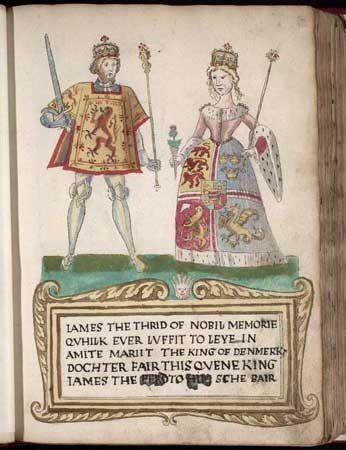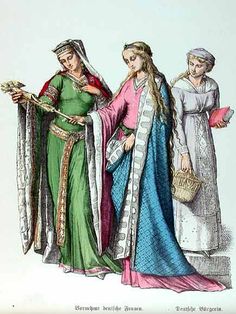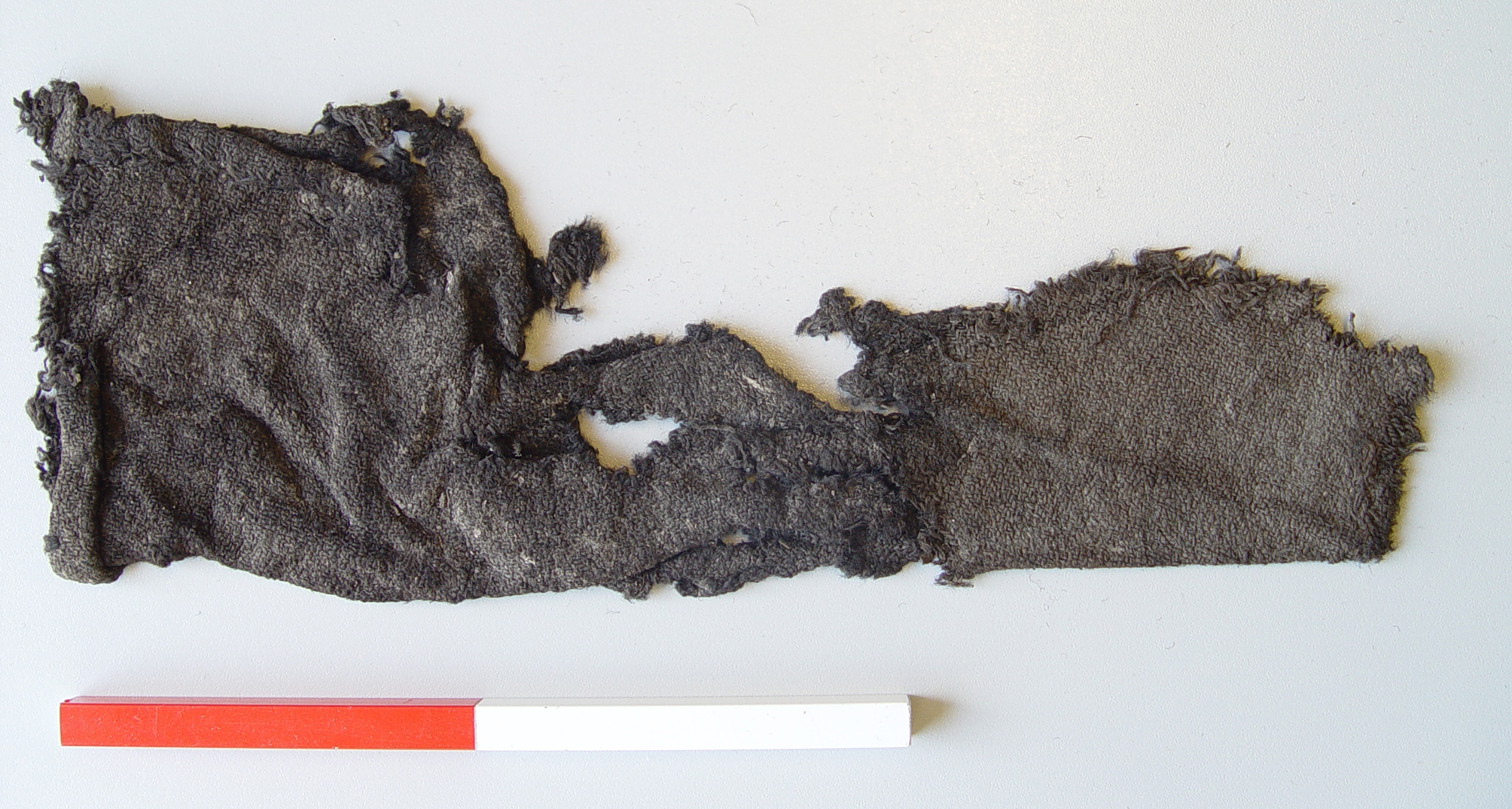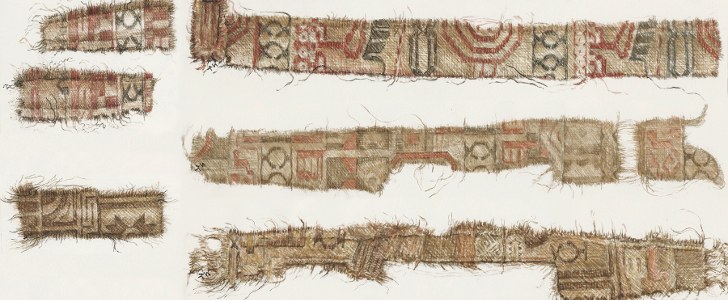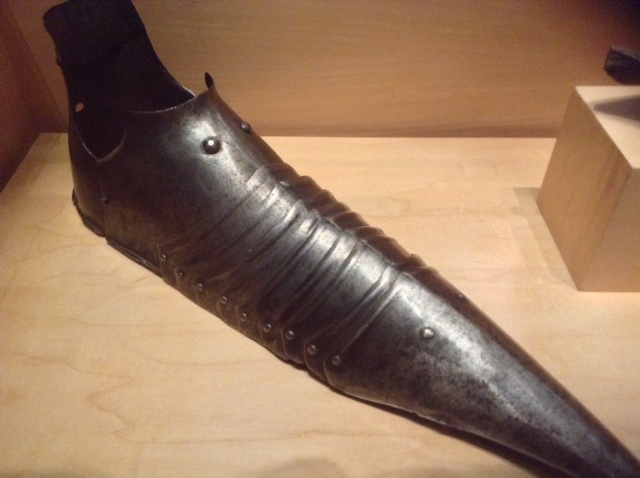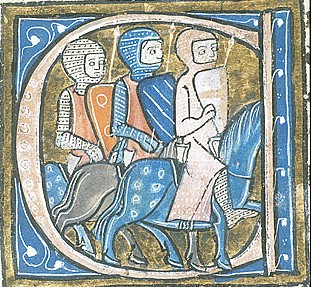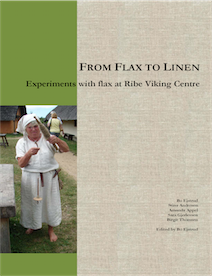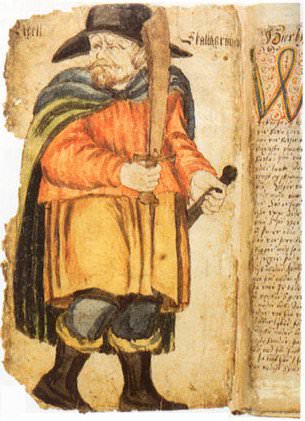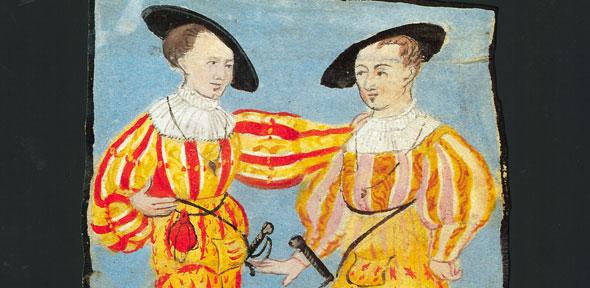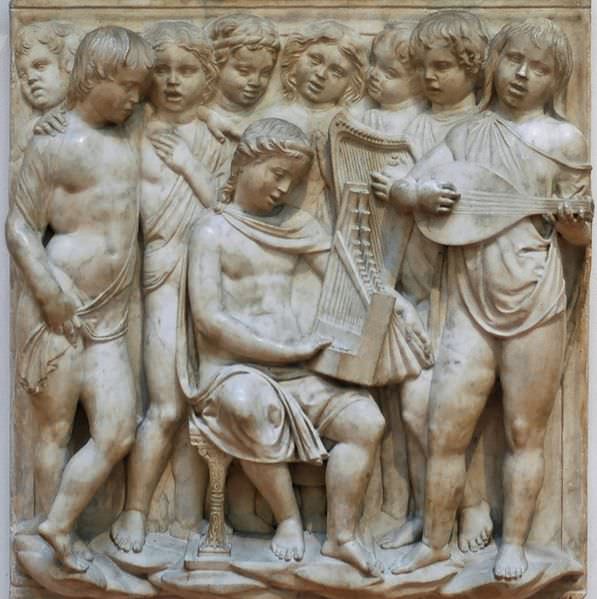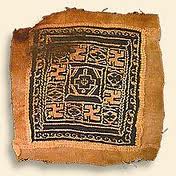The Wardrobe of Margaret of Denmark, Queen of Scotland
Margaret of Denmark dressed at the height of fashion in mid-15th century Scotland.
Fabrics in Medieval Dress in Pomerania
The use of colour effects – motives of stripes, colour ribbon and string additions as well as pieces of embroidery – is a testament to the decorative character of medieval clothes.
Shoes and shoemakers in late medieval Bergen and Stockholm
The purpose of this article is to analyse the differences between shoemakers in late medieval Bergen and Stockholm on one hand, and the differences between the archaeological finds of shoes in the two towns on the other hand.
Estreitement bende: Marie de France’s Guigemar and the erotics of tight dress
This article examines the change in women’s fashion that occurred during the 12th century. Garments went from loose and flowing to tightly fitted, featuring belts and laces. The author examines this cultural change through the romance stories complied in the “Lais” of Marie de France, specifically one featuring the character of Guigemar.
How to pleat a shirt in the 15th century
Based on the shirt fragments from the 15th century found at Lengberg Castle in East-Tyrol this paper describes the methods with which these shirts have been pleated, what type of stiches have been used for sewing and how the trimming strips were fashioned. Seventeen textile fragments could be identified as parts of shirts, fourteen of which feature either partially or totally pleated areas. Two sleeves with textile buttons and button holes, two sleeves with button holes, one sleeve with a textile button, one neckline and five fragments being either sleeve or collar are pleated on their entire width. One shirt each is pleated partially on the front, one of them with a preserved textile button. One sleeveless shirt is pleated at the shoulder.
‘Grandissima Gratia’: The Power of Italian Renaissance Shoes as Intimate Wear
In the Renaissance fashion system gender identification and expressions of power through shoes were instead primarily based on varying degrees of their invisibility.
Persian silk worn by Vikings, researcher finds
When the Oseberg Ship was discovered in Norway in 1904, more than one hundred silk fragments were found among its artefacts. New research has shown that these silks were probably purchased from Persia through a trade network.
Medieval Shoes
What set the trends for medieval shoe styles? The Politics, power, economics and climate behind medieval shoes.
Transvestite Knights: Men and Women Cross-dressing in Medieval Literature
In this thesis, I will look at mainly French and German texts from the 12th to the 15th centuries which deal with the subject of cross-dressers in the decidedly masculine domain of the knight. There are many tales of cross-dressing, particularly of women, but the concept of men dressing as women while jousting, and women dressing as knights, brings up several questions about the clothes, what it meant to be male and female, and how cross-dressing could be viewed on the tournament field.
From Flax to Linen: Experiments with flax at Ribe Viking Centre
The archaeological record shows that linen was an important part of Viking Age clothing. Linen cloth developed gradually from being virtually nonexistent in Scandinavia at the start of the first millennium AD…
The literary significance of clothing in the Icelandic family sagas
We do not often hear about what the character is wearing – and when we do it can be difficult to discern why clothes are being mentioned at this particular point and why only in relation to a certain character.
Making and breaking order via clothing
Following the events which disrupted social stability in fourteenth and fifteenth-century England, individuals from a variety of social contexts demonstrated a particular necessity to see order visibly displayed in society.
The Garments of Guy in the Bayeux Tapestry
In her paper, Gale R. Owen-Crocker looks at how the late 11th century frieze portrays Guy, Count of Ponthieu.
The Queen of Sicily’s Paris Shopping List, 1277
Sarah-Grace Heller examines a letter sent by Charles I of Anjou, King of Sicily to one of his agents in Paris, where he provides a detailed order of textiles and clothing that he needed to have purchased.
Acquiring, Flaunting and Destroying Silk In Late Anglo-Saxon England
This paper will argue that vibrantly coloured silks and other elaborate textiles were ubiquitous in England in the late Anglo-Saxon period.
What did the Renaissance man wear? Historian recreates outfit from the 16th century
In the sixteenth century an accountant in the German city of Augsburg named Matthäus Schwarz was busy moving up the social circles, and he did it in part by knowing the latest fashions and dressing well. By 1541 he succeeded in becoming a member of the nobility. Now his efforts are being recreated in an experimental research project at the University of Cambridge.
Best Clothes and Everyday Attire of Late Medieval Nuns
The habit symbolises humility because it nulifies any difference of estate; it signifies the will to chastity because it disguises the feminine form of the body; and it displays outer obedience to divine com- mands by its timelessly simple cut and fabric of linen or wool. Given this sort of symbolism, fashion and nuns appear to be mutually exclusive themes.
Fashion of Middle England and its Image in Chaucer’s Canterbury Tales
Fashion of Middle England and its Image in Chaucer’s Canterbury Tales Petra Štěpánková Bachelor Thesis, Masaryk University – Brno, Faculty of Education, Department…
Life, Death, Fate and Female Embodiment: Weaving in Viking Age and Medieval Iceland
Video of a lecture on medieval Icelandic textiles.
Beyond fragments and shards: Children in medieval Bergen
By analysing physical remains reflecting the games, behaviour and clothing of children (specifically toys and shoes) it has been possible to obtain new information and shed new light on the everyday life of children in medieval Bergen
Technological Development in Late Saxon Textile Production: its relationship to an emerging market economy and changes in society
The process of change from domestic textile production in early Anglo-Saxon England (5th – mid-7th century) to the more commercially based, organised industry of the late Saxon period (late 9th – 11th century) is a long and complex one.
New research on how the Bayeux Tapestry was made
A University of Manchester researcher has thrown new light on how the world famous Bayeux Tapestry was made over 900 years ago.
Female Dress in Cyprus during the Medieval Period
Cyprus offers ample evidence for the way people dressed in medieval times. Such testimony is preserved in a variety of media: frescoes, icons, effigial slabs and manuscripts.
Coptic Dress In Egypt: The Social Life Of Medieval Cloth
Coptic textiles in most collections present a very rich iconography, somewhat derived from classical traditions, which has also attracted the attention of art historians. Very little of their work, however, has made any headway in our understanding of the contemporaneous meanings of Coptic textile images and other decorations.
Chaucer’s costume rhetoric in his portrait of the Prioress
No critic has ever discussed costume signs in order to reveal to what extent the Prioress does or does not conform in her costume to the fourteenth century norm, with consideration given, simultaneously, to the historical records, literature and visual arts of the period that form and inform the signs from the many traditions Chaucer in corporates in his portrait of the Prioress.
